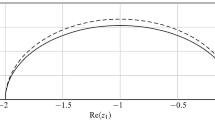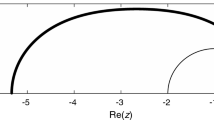Abstract
For many systems of differential equations modeling problems in science and engineering, there are often natural splittings of the right hand side into two parts, one of which is non-stiff or mildly stiff, and the other part is stiff. Such systems can be efficiently treated by a class of implicit-explicit (IMEX) diagonally implicit multistage integration methods (DIMSIMs), where the stiff part is integrated by an implicit formula, and the non-stiff part is integrated by an explicit formula. We will construct methods where the explicit part has strong stability preserving (SSP) property, and the implicit part of the method is A-, or L-stable. We will also investigate stability of these methods when the implicit and explicit parts interact with each other. To be more precise, we will monitor the size of the region of absolute stability of the IMEX scheme, assuming that the implicit part of the method is A-, or L-stable. Finally, we furnish examples of SSP IMEX DIMSIMs up to the order four with good stability properties.
Similar content being viewed by others
References
Braś, M., Cardone, A., Jackiewicz, Z., Pierzchaa, P.: Error propagation for implicit-explicit general linear methods. Appl. Numer. Math. 131, 207–231 (2018)
Braś, M., Izzo, G., Jackiewicz, Z.: Accurate Implicit-Explicit general linear methods with inherent Runge-Kutta stability. J. Sci. Comput. 70, 1105–1143 (2017)
Butcher, J.C.: Diagonally-implicit multi-stage integration methods. Appl. Numer. Math. 11, 347–363 (1993)
Butcher, J.C.: Numerical Methods for Ordinary Differential Equations. Wiley, Chichester (2003)
Califano, G., Izzo, G., Jackiewicz, Z.: Starting procedures for general linear methods. Appl. Numer. Math. 120, 165–175 (2017)
Califano, G., Izzo, G., Jackiewicz, Z.: Strong stability preserving general linear methods with Runge-Kutta stability. J. Sci. Comput. 76(2), 943–968 (2018)
Cardone, A., Jackiewicz, Z., Sandu, A., Zhang, H.: Extrapolation-based implicit-explicit general linear methods. Numer. Algorithm. 65, 377–399 (2014)
Cardone, A., Jackiewicz, Z., Sandu, A., Zhang, H.: Construction of highly stable implicit-explicit general linear methods, Discrete Contin. Dyn. Syst Dynamical systems, Differential Equations and Applications, 10th AIMS Conference Suppl., pp. 185–194 (2015)
Constantinescu, E.M., Sandu, A.: Optimal strong-stability-preserving general linear methods. SIAM J. Sci. Comput. 32, 3130–3150 (2010)
Gottlieb, S., Ketcheson, D., Shu, C.-W.: Strong Stability Preserving Runge-Kutta and Multistep Time Discretizations, World Scientific. New Jersey, London (2011)
Hindmarsh, A.C.: ODEPACK, A systematized collection of ODE solvers. In: Stepleman, R.S., et al. (eds.) Scientific Computing. (vol. 1 of IMACS Transactions on Scientific Computation), pp. 55–64. Amsterdam, North-Holland (1983)
Hundsdorfer, W., Ruuth, S.J.: IMEX Extensions of linear multistep methods with general monotonicity and boundedness properties. J. Comput. Phys. 225, 2016–2042 (2007)
Hundsdorfer, W., Verwer, J.G.: Numerical solution of Time-Dependent Advection-Diffusion-Reaction equations. Springer, Berlin (2003)
Izzo, G., Jackiewicz, Z.: Highly stable implicit-explicit Runge-Kutta methods. Appl. Numer. Math. 113, 71–92 (2017)
Izzo, G., Jackiewicz, Z.: Strong stability preserving general linear methods. J. Sci. Comput. 65, 271–298 (2015)
Izzo, G, Jackiewicz, Z: Strong stability preserving transformed DIMSIMs. J. Comput. Appl. Math. 343, 174–188 (2018)
Izzo, G., Jackiewicz, Z.: Strong stability preserving transformed implicit-explicit DIMSIMs, arXiv:1806.07804
Jackiewicz, Z.: General Linear Methods for Ordinary Differential Equations. Wiley, Hoboken (2009)
Jin, S.: Runge-kutta methods for hyperbolic systems with stiff relaxation terms. J. Comput. Phys. 122, 51–67 (1995)
Ketcheson, D.I., Gottlieb, S., Macdonald, C.B.: Strong stability preserving two-step Runge-Kutta methods. SIAM J. Numer. Anal. 49, 2618–2639 (2011)
Pareschi, L., Russo, G.: Implicit-explicit Runge-Kutta schemes and applications to hyperbolic systems with relaxation. J. Sci. Comput. 25, 129–155 (2005)
Schnakenberg, J.: Simple chemical reaction systems with limiting cycle behaviour. J. Theor. Biol. 81, 389–400 (1979)
Schur, J.: Uber Potenzreihen die im Innern des Einheitskreises beschrankt sind. J . Reine Angew. Math. 147, 205–232 (1916)
Shu, C.-W.: High order ENO and WENO schemes for computational fluid dynamics. In: Barth, T.J., Deconinck, H. (eds.) High-Order Methods for Computational Physics, Lecture Notes in Computational Science and Engineering, vol. 9, pp. 439–582. Springer (1999)
Spijker, M.N.: Stepsize conditions for general monotonicity in numerical initial value problems. SIAM J. Numer. Anal. 45, 1226–1245 (2007)
Wang, R., Spiteri, R.J.: Linear instability of the fifth-order WENO method. SIAM J. Numer. Anal. 45, 1871–1901 (2007)
Zhang, H., Sandu, A., Blaise, S.: Partitioned and implicit-explicit general linear methods for ordinary differential equations. J. Sci. Comput. 61, 119–144 (2014)
Author information
Authors and Affiliations
Corresponding author
Additional information
Publisher’s note
Springer Nature remains neutral with regard to jurisdictional claims in published maps and institutional affiliations.
Members of the INdAM Research group GNCS.
Rights and permissions
About this article
Cite this article
Izzo, G., Jackiewicz, Z. Transformed implicit-explicit DIMSIMs with strong stability preserving explicit part. Numer Algor 81, 1343–1359 (2019). https://doi.org/10.1007/s11075-018-0647-3
Received:
Accepted:
Published:
Issue Date:
DOI: https://doi.org/10.1007/s11075-018-0647-3




